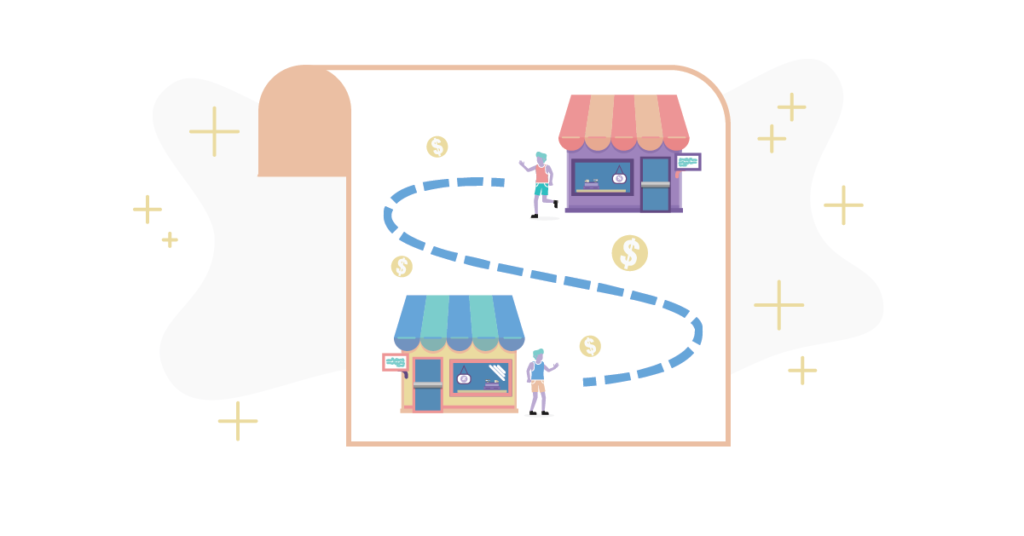Consumers have spent $3.53 trillion worldwide with online merchants so far in 2019, and B2C ecommerce — or business-to-consumer electronic commerce — sales are only expected to increase in coming years. This type of ecommerce encompasses any purchase a consumer makes from an online retailer, such as Amazon or Etsy, and is generally what comes to mind when you think of online shopping.
However, there’s another type of ecommerce that doesn’t receive nearly as much attention but boasts even greater sales. In fact, B2B ecommerce, or business-to-businesses electronic commerce, is predicted to reach $6.7 trillion in revenue by 2020, according to business consultant firm Frost & Sullivan.
Why is this number so much larger? And how can your online business tap into the B2B ecommerce market? Read on to find out.
B2B Ecommerce: What is it?
B2B ecommerce is the sale of goods and services from one business to another through an online or digital portal. Traditionally, B2B transactions ocurred over the phone or by email and involved buyers contacting sales representatives directly. But the rise in B2B ecommerce has increased efficiency and reduced overhead costs by permitting buyers to place orders online.
While you may think of B2B ecommerce as happening on only a massive scale or among large companies, online sellers of any size can be involved. In fact, many sellers may be engaged in B2B ecommerce without realizing it because B2B ecommerce can involve selling wholesale, distribution relationships with retailers; selling to organizations; or selling to resellers. For example, if you sell hand-knitted scarves in your online store, and a brick-and-mortar retail shop makes a wholesale order of scarves to resell in their shop, you’re involved in B2B ecommerce.
How does B2B ecommerce differ from B2C ecommerce?
If you have an online store, you’re already familiar with both sides of the B2C ecommerce relationship. You already sell directly to consumers, and you’ve likely made an online purchase before, whether it was from a retail giant like eBay or Amazon or from an entrepreneur who runs an Etsy shop or Shopify-based store. In some ways, B2C and B2B ecommerce are similar because both involve buying and selling goods and services online or through a digital portal. However, there are a few key differences between the two that are worth noting.
Purchase frequency
- The purchasing needs of consumers and businesses are different in two distinct ways:
- B2C purchases are often one-time purchases, while B2B are typically long-term or recurring purchases.
- B2C purchases may be impulse buys, while B2B purchases are generally planned and scheduled in advance, perhaps even on a regular basis.
Pricing
- Prices for B2C buyers typically aren’t negotiable, but prices for B2B buyers usually are. While most consumer-focused ecommerce sites have fixed prices — with the exception being auction-like listings on eBay, for example — in B2C ecommerce, there are usually negotiations. B2B buyers may also receive discounts for placing bulk orders or for being longtime customers.
Decision-makers
- Only the buyer is typically involved in B2C purchases, but B2B purchases may involve not only numerous people but also various departments within a business. For example, while you may be the sole decision-maker when determining what items you’ll personally purchase from Amazon, when making a buying decision on behalf of a company, there may be several steps or layers of approval involved.
Delivery times
- While B2C buyers are often looking for speedy delivery — such as Amazon Prime’s free two-day shipping — B2B buyers are generally more concerned with receiving regular deliveries on a reliable schedule.
Payment times
- B2C purchases can usually be made by various means, including credit card or PayPal, and payment is received before goods are shipped. However, B2B payments may be negotiated by different terms, and payment may not be required until after goods are shipped or delivered.
Why B2B ecommerce is growing
B2B ecommerce is one of the fastest-growing sectors of ecommerce for several reasons.
For one, B2B ecommerce simplifies the shopping experience for sellers. Instead of placing orders by phone or email or during specific business hours, buyers can place orders online at any time. In fact, 74% of B2B buyers say that buying from a website is more convenient than placing an order with a sales representative, and 57% of B2B customers want access to their accounts online, according to Forrester.
By the time B2B buyers decide to make a purchase, they’ve generally already completed a significant amount of research independently. And once a B2B buyer knows what they want, 93% report that they’d prefer to make that purchase through a digital portal.
B2B ecommerce also reduces sellers’ overhead costs because they don’t have to employ sales representatives to receive orders. Instead, they can create a user-friendly ecommerce website that allows buyers to access product catalogs, make purchases, review orders and track shipments.
Millennials make more than 60% of their purchases online, and as they become a larger part of the workforce, B2B ecommerce is predicted to grow. In fact, 73% of millennials report that they already have some involvement in company purchasing decisions.
Finally, more people inside organizations are empowered to make product recommendations and purchases — and it’s often coming from the bottom up. While at one time department heads and managers made purchasing decisions, this is changing as end users, or the people who actually use a product, gain greater influence within a company.
End users may already be aware of the products they want to use, and, today, they’re also able to easily conduct product research online or receive recommendations from trusted sources on social media. This is causing a noticeable shift in who wields the buying power, and marketers are taking notice. As investor Blake Bartlett explains, “End users are finding products on their own and telling their bosses which ones to buy. And it’s all happening at lightning speed.”
B2B Ecommerce: Tips for success
More than half of B2B buyers are willing to access product information online and make a purchase online, according to Statista. So it’s important that your B2B ecommerce business not only be set up and optimized for online sales but also take advantage of B2B ecommerce strategies to ensure that it’s gaining exposure and attracting buyers.
If you’re moving into the B2B ecommerce space and looking to grow your business, check out this post from Sapphire Ventures that highlights strategies to help Internet companies grow. And be sure to keep the following best practices in mind as you set up your website, market to potential buyers, and engage with your customers.
Make your ecommerce site user-friendly and mobile-friendly.
If you want to entice customers to purchase from you, your website should be easy to access and use, especially when it comes to repeat purchases; a negative user experience may prompt a customer to take their business elsewhere. Invest in UX and run tests to see how you can improve user experience. To learn more about how visitors arrive at your website, what barriers make them leave, and how you can increase conversions, check out this article from Hotjar.
A mobile-ready site or even an app is a must-have element for B2B ecommerce because mobile purchases are on the rise. In fact, according to research conducted by Google and Boston Consulting Group, mobile drives or influences more than 40% of revenue among major B2B companies. The research also notes that the share of mobile traffic will take up as much as 70% of B2B-related searches by 2020.
Start by ensuring that your ecommerce site is mobile-friendly. Take a look at how it displays on mobile devices and how easy it is to navigate. You can also test the speed of your website on both mobile and desktop — a slow website can increase abandoned-cart rates by as much as 75%.
Provide an in-depth product catalog.
B2B buyers often make large and recurring orders, so they need to know everything about the product they’re ordering. While you may employ sales representatives or customer service representatives who can answer any product questions, it’s best to give customers all the information they may need about your products.
You can do this by providing a digital catalog or searchable product database. On product pages, include spec sheets, reviews, and installation guides, as well as photos and videos of the items.
In the example from WholesalePet.com, below, the product information for the pet stroller includes various dimensions and detailed explanations of product features, and you can even download additional product data.
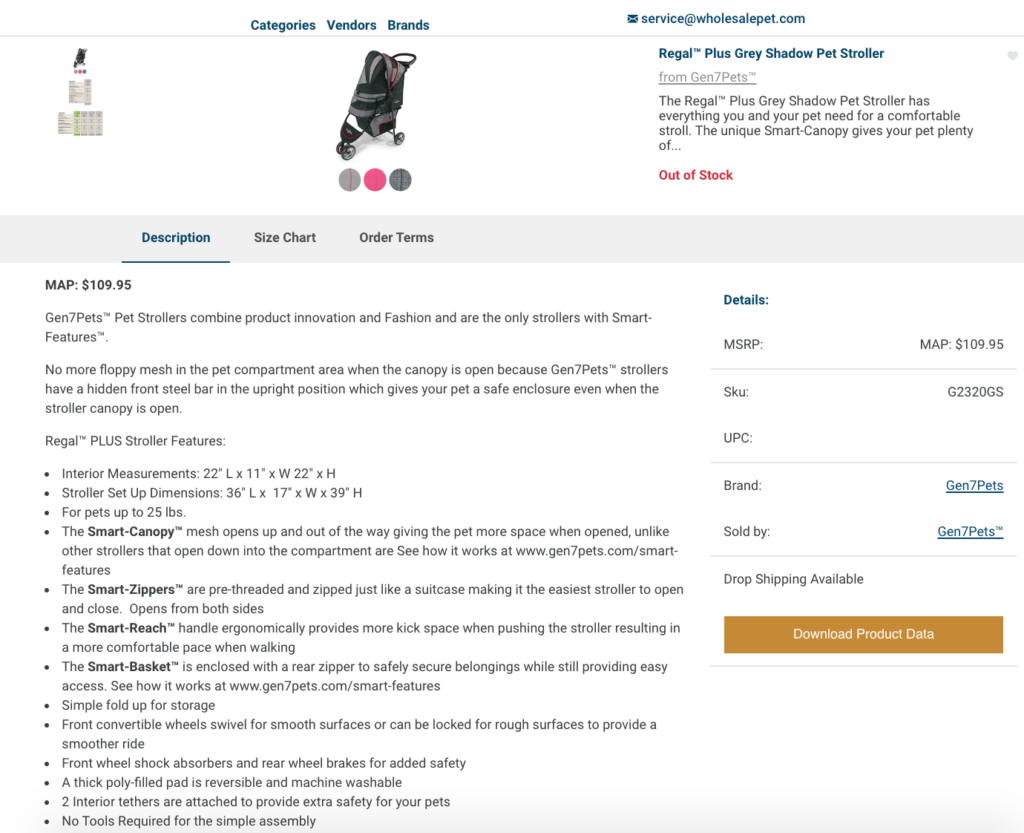
Making product information easily available not only helps your customer find and purchase the correct products but also instills trust. Buyers will feel better making a purchase from a company that’s thorough and detail-oriented about every item in their digital catalog.
Make it easy for website visitors to write and see customer reviews.
Just like B2C buyers, B2B buyers want to do business with reliable suppliers that have a good reputation, and in B2B, establishing trust is perhaps even more important. One of the best ways to do this is to prominently feature customer reviews and testimonials on your website.
You can encourage customers to post reviews by first making it easy to navigate to the review section of your ecommerce site. You can also follow up with customers and request feedback, feature on-site prompts to repeat customers, or offer discounts or other loyalty bonuses to customers who write reviews.
Offer bulk ordering and subscription services.
Because B2B companies generally order much larger volumes than B2C buyers, you can offer incentives to purchase from your business in the form of discounted prices for bulk orders. You can also offer a discounted rate if a buyer subscribes to an item or sets up a recurring shipment. For example, Amazon even does this for consumers with products like vitamins and pet food, offering a slightly cheaper rate to customers who subscribe to an item, as shown in the screenshot below.
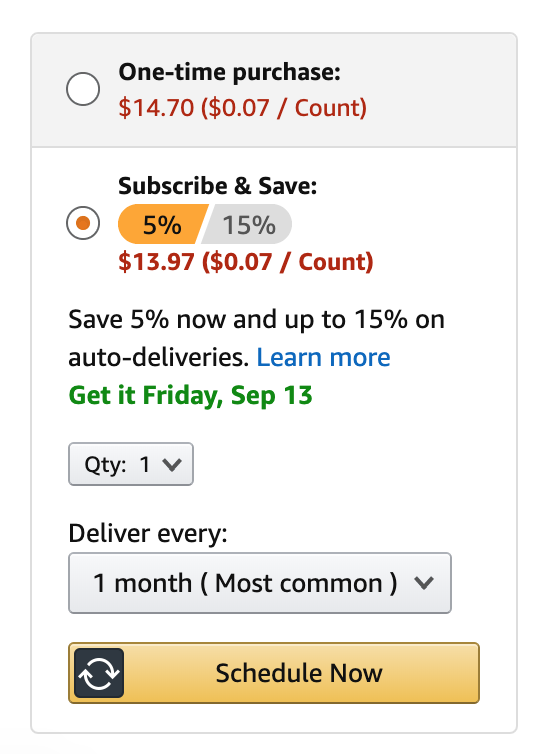
Establish a loyalty or reward program.
Offering a customer loyalty or reward program is a great way to attract B2B buyers, drive conversion, and develop long-term business relationships. B2B buyers are looking for long-term partnerships with sellers, as well as savings, so these programs have a lot of appeal.
There are a variety of ways you can set up a loyalty or reward program, and it can be beneficial to tailor these programs to each individual customer to increase value. For example, you may want to offer tier incentives and reward repeat B2B buyers with discounted prices because they increase purchasing volumes. This not only offers value to the buyer but also incentivizes them to purchase more to reach higher tiers. You could also consider a referral program and give discounts or bonuses to buyers when they refer another buyer to your business.
Provide multiple ways for customers to get in touch.
Part of the appeal of B2B ecommerce is that it allows buyers the flexibility and autonomy to place orders at any time, and it can reduce overhead costs for sellers because they may not require as many sales representatives. However, it’s still important for buyers to be able to reach a sales or customer service representative if they have product questions, technical issues, or any other problem. In addition to providing a phone number and an email address for B2B buyers to reach you, also consider using a live-chat feature.
For example, in the screenshot from Handi Medical Supply, below, a phone number is prominently displayed, and you can click “chat now” at the top of the screen to initiate a live chat with an associate.
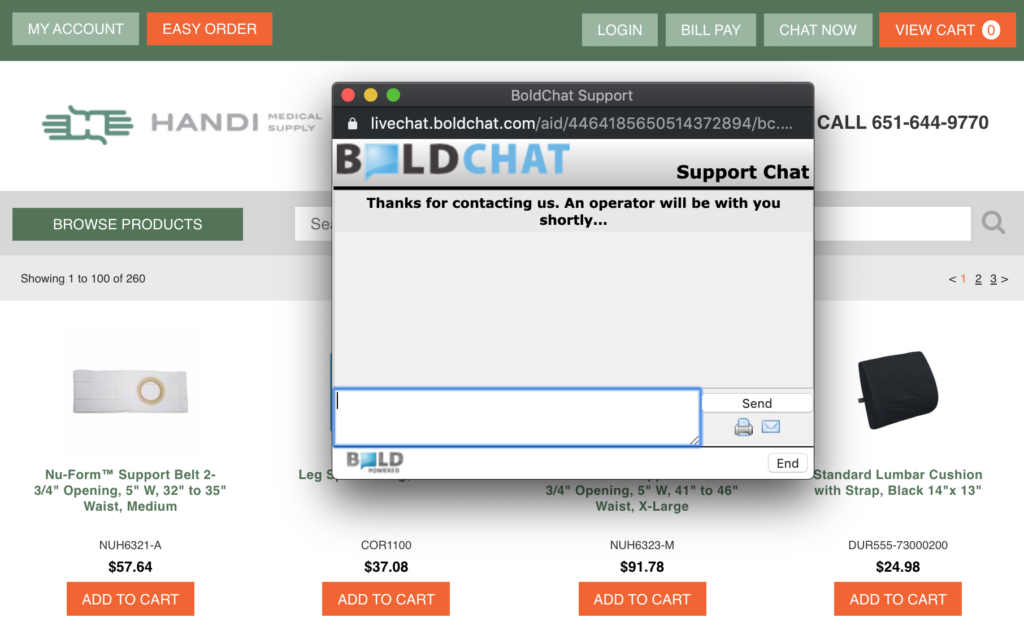
This enables buyers to get real-time assistance and gives a human touch to your ecommerce site that increases customer satisfaction.
Employ email marketing at every touchpoint.
The median email marketing ROI is 122%, according to an eMarketer study — that’s four times greater than any other digital marketing medium. So email marketing should be a significant part of your B2B ecommerce marketing strategy.
You can use email marketing at every touchpoint with B2B buyers by sending welcome emails, informing them of loyalty or reward programs, providing updates on orders and shipments, reminding them of products they viewed on your website, or prompting them to return to your store if they’ve abandoned their cart.
Research shows that the most lucrative types of emails you can send are upselling and cross-selling emails. In fact, when these types of emails are sent after a B2B buyer makes a purchase, they have an open rate of nearly 62%. There are many ways you can send these emails, but the two most common are follow-up emails that incentivize another purchase by including a discount or exclusive offer, and follow-up emails that cross-sell by providing buyers with customized product suggestions that are similar or related to a previous purchase.
Develop a successful abandoned-cart strategy.
On average, ecommerce carts are abandoned at a rate of nearly 70%, so developing a strategy to lower your abandonment rate can increase your conversions and profits. B2B buyers may abandon carts for a variety of reasons, but often it comes down to price and timing. You can attempt to reengage these potential buyers by using emails and web ads to retarget and even by offering a discount if the buyer completes their purchase within a specific period, such as in the example below.
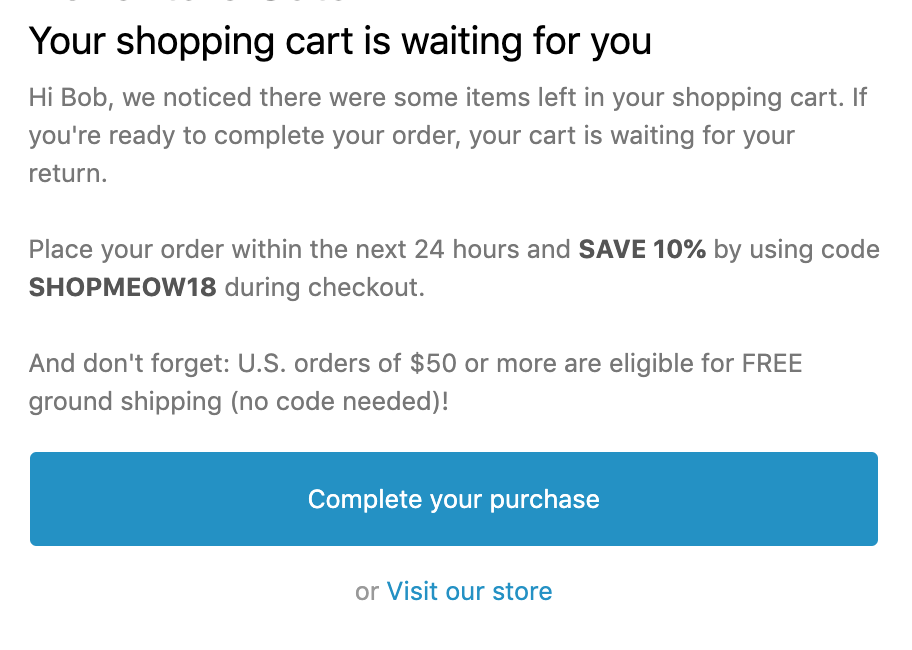
Check out this article to learn more about abandoned-cart best practices.
Identify customer buying patterns for remarketing.
Pay attention to customer buying patterns, so you can gauge the best time to begin remarketing. For example, if one of your top B2B buyers is making repeat purchases every four months, you may want to begin reaching out to them with email reminders every two months, providing them with a two-month window to restock. You can further incentivize them with exclusive offers or discounts. These types of remarketing efforts not only have the potential to increase your revenue but also can increase customer satisfaction.
Put the customer first
With its rapid and continuous growth, B2B ecommerce is clearly a market that’s worth pursuing. However, with the large orders and sales figures typically involved, it’s easy to get caught up in the numbers of business and overlook the most important component of B2B ecommerce: the customer.
B2B ecommerce may occur on a different scale from B2C ecommerce, but the key to success in both is to keep your customers’ interests in the forefront and always put them first. Designing your ecommerce site with customer needs in mind, offering top-notch service, and providing value at each step of the sales process will ensure that customers keep coming back.
